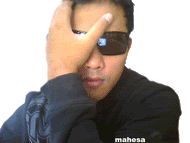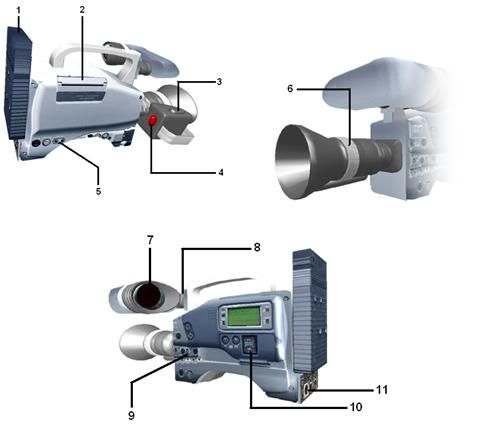Image retrieval techniques
There are a few things to note relating to the camera device.
Before any shooting is a good idea if a cameraman preparations as follows:
- Mastery of the camera device to be used. Should follow the written rules on the use of the manual book. Understand the strengths and weaknesses.
- Once familiar with the ins and outs of the camera, the scene also understand what and how the technique is desired.
- Creating a breakdown of equipment to be used like a battery, microphone, extension cord, etc..
- Make sure the battery in good shape and full, and all the facilities at the camera worked well.
In video production activities / movies, there are many types of cameras used.
The division of a video camera / film divided over the media used to store data (image & sound) that have been taken.
Just as in photography, who has taken pictures stored on the roll of film.
But in this type of camera, film rolls in addition there are also magnetic tape to store the voice data.
In a 1-second shots, it takes about 30 frames the film.
The type of film used is a positive film (slides), in which to view its contents should be washed in the laboratory first film and is projected by using a special projector.
This type of camera stores images and sound data on magnetic tape.
Generally there are 2 types of cameras:
Analog (AV)
The data is stored as a stream of strong signals (waves) on the camcorder tape.
This type of camera types including VHS, S - VHS, 8mm, and Hi - 8.
Digital (DV)
Camera digital video recorder stores data in binary code format of bits per byte which consists of series 1 (on) and 0 (off).
Types of cameras include mini DV, and Digital 8.
In general, the parts consisting of a video camera:
- Battery for power supply
- lace tape
- Zoom
- Recorder button
- Output port video / audio (can be analog or digital)
- Focus Ring
- Preview window (View Fender)
- Microphone
- Light controls
- Keys Player (for playing back video).
- DC input terminal.
In addition there are also many additional facilities that vary between one camera with another camera.
Facilities include an infrared light for shooting in dark places, edit the text directly from the camera, the effects of other video, slow motion and much more.
Taking pictures of an object can be done in five ways:
· Bird's Eye View
Shooting technique done with a camera height above the height of the object. The result will look spacious environment and other things seem small and scattered.
· High Angle
Angle of the objects that look so impressive small objects. This technique has a dramatic impression of the value of "dwarf".
· Low Angle
Angle from the direction of the objects that look so impressive large objects. This technique has a dramatic impression of great value / prominance, authoritative, powerful, dominant.
· Eye Level
The results showed catch someone's eye view. This technique does not have a dramatic but natural impression.
· Frog Eye
Shooting angle with the height of the camera parallel to the base / bottom position of the object or lower. The result will look as if the audience's eyes represent the eyes of frogs. Image size is usually associated with shooting purposes, the level of emotions, situations and Events object. There are a variety of terms such as :
· Extreme Close Up (ECU / XCU) : the image is a very detailed look like a player's nose or lips or tip of the heel of the shoe.
· Big Close Up (BCU) : taking pictures from head to chin length.
· Close Up (CU) : images taken from close range, only part of the object that looks like just his face alone, or a pair of new shoes legs
· Medium Close Up (MCU) is similar to MS, if the object of people and taken from the chest upwards.
· Medium Shot (MS): retrieval of medium-range, if the object of it is visible only half his body alone (from the stomach / waist up).
· Knee Shot (KS): taking a picture object from head to knee.
· Full Shot (FS): the image is fully object from head to toe.
Images taken from a distance, all objects exposed to the background object.
· Medium Long Shot (MLS): images taken from a reasonable distance, so if for example there are 3 objects of the whole will be seen. If the object is a person looking from head to knee.
· Extreme Long Shot (XLS): images taken from very far distance, you'll enjoy no longer the object but the background. Thus it can be seen the position of the object to its environment.
· One Shot (1S): Taking pictures of objects.
· Two Shot (2S): taking pictures of two people.
· Three Shot (3S): taking pictures of three people.
· Group Shot (GS): the image is a group of people.
Camera movement will produce a different picture. Therefore it is distinguished by the terms as follows:
· Zoom In / Zoom Out: the camera moves away and approached the object by using the zoom button in camera.
· Panning: camera movement looked to the left and right of the tripod.
· Tilting: move camera up and down.
Tilt Up if the camera tilt up and down if the camera nodded.
· Dolly: the position of the camera on the tripod and on the basis of its wheels. In Dolly if it moves forward and Dolly Out if it moves away.
· Follow: camera movements follow a moving object.
· Crane shot: the camera movements are mounted on the crane wheels.
· Fading: change the image slowly.
If the images fade in and fade out appears if the image disappears and the cross-fade if the image 1 and 2 interchanged simultaneously.
· Framing: framing the object is in the Shot.
In the frame when entering the frame and the frame out if the exit frame.
Shooting techniques without moving the camera, so quite a moving object.
· Object moves parallel to the camera.
· Walk In: The object moved toward the camera.
· Walk Away: Objects moving away from the camera.
This technique is said because not only rely angle, image size, camera movements and objects but also other elements such as light, property and the environment. Average shooting by using these techniques produce more dramatic impression.
· Backlight Shot: shooting techniques to lighting on the object from behind.
· Reflection Shot: making techniques that are not directed to its object but from the mirror / water that can reflect the image of the object.
· Door Frame Shot: pictures taken from outside the door while the scene was in the room.
· Artificial Framing Shot: objects such as leaves or twigs placed in front of the camera so as if the object is taken from behind the branches.
· Jaws Shot: menyorotobjek camera as if surprised to see the camera.
· Framing with Background: the object of focus in front of the background but there appear so beautiful impression.
· The Secret of Foreground Framing Shot: making objects that were in front until the background so that the fusion scene.
· Tripod Transition: the camera position above the tripod and move from one object to another object rapidly.
· Artificial Hairlight: given the object hair effects of artificial light so shine and more dramatic.
· Fast Road Effect: teknikyang taken from the car was speeding.
· Walking Shot: This technique takes a picture of the current object.
Usually used to indicate who was walking in a hurry or pursued by something.
· Over Shoulder: taking pictures from behind the object, the object is usually only seen the head or shoulders only. Obtaining this to show that the object was seeing things or objects can also chatting.
· Profile Shot: if two people are in dialogue, but the shot from the side, one showing the camera first and second camera showed the second person.
Scripts serves as a guide for us in making the film, meant to guide us in taking pictures and sound.
So a script usually contains about the sequence of images that must be taken with a camera and a voice that must be recorded either in the form of narration, dialogue, music and sound effects. For convenience, (for beginners) sheet of manuscript is divided into two columns. In the left column written order of the image to be captured by the camera and an explanation of the shooting angle. So in this column can be known whether the pictures should be taken in close up, medium shot, long shot, and so on. Camera movement from left to right, top down, much to the close and so may also be written in this column. This column is called the visual field. While to the right column included narration or dialogue of the players, music, sound effects and other sounds to be recorded. In this column can be known whether the recorded voice or background of the transition and so on. This column is called an audio column.To distinguish, all information that is not voiced by uppercase, while the dialog that the player will read characters written in small letters.
Identification Program
Contains program identification information about the program or movie will be produced. Title, duration, format of the program, and others may be included in this section.
Synopsis
Synopsis or summary of the story needed to provide a brief description and dense on the theme or main story in the film overall.
Synopsis may contain the following things:
· Outline of the story.
· People protagonists.
· People antagonist.
· Important figures directly supporting the main plot and sub plots.
Problema · main and important problems-problems that were very influential in the story.
· Main motives and motifs important action helper.
· Climax and resolution
· Conclusion.
Treatment
Before the script into a screenplay it is very necessary to create treatments. Treatment is a description that describes the flow of the presentation of a film story. Somewhat different with a synopsis, treatment to try to give a brief description of deskriptis about how an episode of a story. By reading treatment we get an idea of the sequence of visual scenes that would appear on the screen. Ways of delivery in the treatment must have filmik and seplastis may be easy to imagine and to stimulate the imagination. The reader is expected to be able to imagine the scene in question.
Story Board
Storyboard is a series of images that describe the details of making a scene by scene. Normally such a scene drawn comic format. In this case no drawing skills required, which overlooked the picture can be understood and translate the scene.
Scenario
Scenario is a script that contains a story or idea that has been designed presentation, so communicative and interesting films presented by the media. Another name is the screenplay or movie script. Scenarios are operational guidance in the implementation of the shooting. In this scenario techniques have appeared and shot the full dialogue. Because the scenario is more of a working script in the field, then the description lines must too short, so quick to give understanding, and soon the movie projected on the reader's imagination.
Download Synopsis and password













0 comments:
Post a Comment